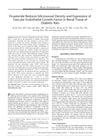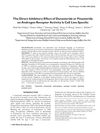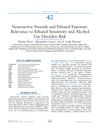TLDR Allopregnanolone changes gene expression in glioblastoma cells.
The study investigated the effects of allopregnanolone (3α-THP), progesterone (P4), and finasteride (F) on gene expression in U87 human glioblastoma cells, revealing that 3α-THP significantly altered 137 genes, F changed 90, and P4 modified only six. Both 3α-THP and F up-regulated genes involved in DNA integrity, replication, and cytoskeleton reorganization. The study validated changes in 10 selected genes, with 3α-THP up-regulating six. Combined treatments showed distinct gene expression changes, suggesting F modulates the effects of P4 and 3α-THP. The findings highlighted the potential of 3α-THP and F in influencing glioblastoma cell behavior and suggested further research to explore their clinical applications.
 25 citations
,
January 2017 in “Steroids”
25 citations
,
January 2017 in “Steroids” Allopregnanolone increases growth and changes gene activity in human brain cancer cells.
 7 citations
,
March 2015 in “The American Journal of the Medical Sciences”
7 citations
,
March 2015 in “The American Journal of the Medical Sciences” Finasteride helps reduce blood vessel growth in diabetic rat kidneys.
 12 citations
,
June 2013 in “The Prostate”
12 citations
,
June 2013 in “The Prostate” Dutasteride and finasteride affect different cell types differently.
 218 citations
,
December 2011 in “Advances in Urology”
218 citations
,
December 2011 in “Advances in Urology” The document concludes that the 5 alpha-reductase enzymes are important in steroid metabolism and related to various human diseases, with inhibitors used to treat conditions like male pattern baldness and prostate issues.
 37 citations
,
January 2009 in “Sexual Development”
37 citations
,
January 2009 in “Sexual Development” Fadrozole and Finasteride change frog sex ratios and cause intersex animals with altered gene expressions.
 25 citations
,
January 2017 in “Steroids”
25 citations
,
January 2017 in “Steroids” Allopregnanolone increases growth and changes gene activity in human brain cancer cells.
 223 citations
,
December 2010 in “The Journal of Sexual Medicine”
223 citations
,
December 2010 in “The Journal of Sexual Medicine” Some patients taking finasteride or dutasteride may have ongoing sexual problems and depression even after stopping the medication.
 1 citations
,
January 2019 in “Elsevier eBooks”
1 citations
,
January 2019 in “Elsevier eBooks” Neuroactive steroids may affect the risk and treatment of alcohol use disorders.
 123 citations
,
December 2015 in “Journal of Neuroendocrinology”
123 citations
,
December 2015 in “Journal of Neuroendocrinology” New targets for making and using brain-synthesized steroids could lead to better treatments for brain disorders and alcoholism.
 65 citations
,
January 2011 in “Frontiers in Endocrinology”
65 citations
,
January 2011 in “Frontiers in Endocrinology” Neurosteroids show promise for treating epilepsy and more research is needed.








